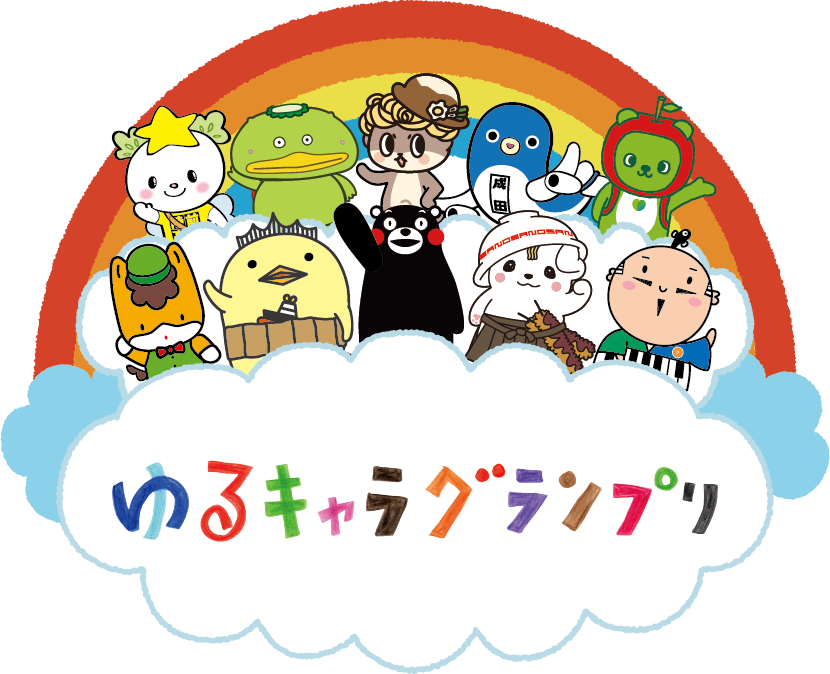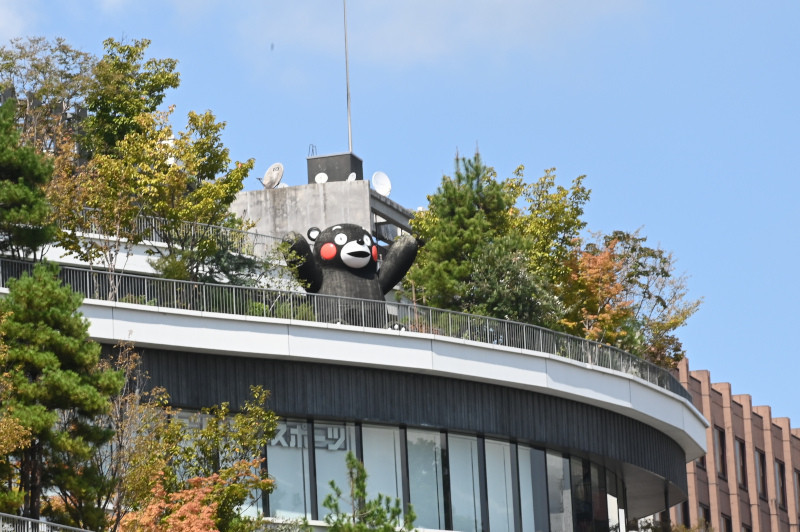If you go anywhere in Japan, you'll notice characters everywhere! These are most likely yuru-chara, characters created intentionally for PR purposes for government offices, regions, services, schools, etc. Learn more about them and the popular ones you should know!
Header © Myaku-myaku, Kumamon, Hikonyan
First Published: 2022/11/25
Updated: 2023/12/06
Table of Contents
- What are yuru-chara (yurukyara)?
- Yuru-kyara Grand Prix
- Why are there so many mascots?
- 5 Famous and Popular Yuru-chara
- Yuru-chara Ranking - Our Original!
- To Close
What are yuru-chara (yurukyara)?

ゆるキャラ or Yuru-chara are essentially Japanese mascots used for PR - but for basically everything. You will find these cute (or sometimes strange/comical) characters accompanying everything from government signs to famous events, etc.
Yuru-chara is actually short for ゆるいキャラクター (yurui character) which translates to something like “loose/laid-back/relaxed character”. Some people say it’s from the way the character looks - usually veering on the cute healing type - and some say it’s based on the way they make people feel when they see the character. Perhaps it’s both!
(If we could present one more less serious opinion, perhaps it’s also referring to how they’re allowed to be created and used so “loosely” in everything.)
What do we mean? Here are some of the places you’ll see yuru-kyara in Japan
-
prefecture offices
-
ward offices
-
hospitals
-
schools, universities
-
festivals and street fairs
-
businesses
-
sports events
-
on TV and YouTube
and more.
Is there a difference between them and other characters?
As the definition of yuru-chara is quite “loose”, for the lack of a better term, people often wonder what counts as yuru-chara and what doesn’t.
For example, do sports team mascots count as yuru-chara? How about official mascots for events? What about characters like Disney characters, Sanrio characters, game characters?
It’s actually quite difficult to pin down the exact boundaries of what counts. Some people believe that any character created to promote something is a yuru-chara. Or any character that has a 着ぐるみ (kigurumi) or an actual full-body costume suit worn at events.
The closest term to yuru-chara are ご当地キャラ (gotouchi kyara). These are regional characters created to promote a specific prefecture or city and thus have a similar meaning to yuru-chara. These characters specifically have something related to the region they are promoting incorporated directly into their design. (For example, Bari-san of Imabari City is a giant baby chicken in a city famous for its yakitori or grilled chicken.)
Words that are a little more ambiguous include マスコットキャラクター (mascot character), オフィシャルマスコット (official mascot) and イメージキャラクター (image character). Is any mascot a yuru-chara?
But as the definition is again, quite “loose”, we’ll say yes.
However, we do draw the line at anime and other animated characters (like Disney, Pixar, Sanrio), as those have a different purpose than to simply promote a region or business.
We do recognize that the line does get blurry when yuru-chara are so popular that they star in their own animation. (See Go-chan, the cute panda prince who represents TV Asahi). But again, the original purpose behind its creation is key.
Writer's Pick
Yuru-kyara Grand Prix

©Yuru-chara Grand Prix
Yuru-kyara used to be a booming business (it still is, but the nationwide hype has settled down overall), that there was even a Yuru-kyara Grand Prix from 2011 to 2020.
Cities and prefectures would create and then enter the yuru-chara into the annual contest, complete with a profile about the mascot’s origin story and personality. People would then vote for their favorite.
Some of the most popular yuru-chara in Japan came from this contest, including Kumamon (Kumamoto Prefecture; more on him later), Bari-san (Imabari City), Sanomaru (Tochigi Prefecture) and more.
The contest ended in 2020, said to be for a variety of reasons including COVID-19, the oversaturation of yuru-kyara, voting controversies, and more.
However, it cemented the idea that at the very least, each region should have a recognizable character that promotes that food, tourist locations and events of the area.
You can find a list of past winners here. Just click on the year!
Why are there so many mascots?
つぎは11時30分くらいに出るよー pic.twitter.com/eUeVFOG28v
— 大崎一番太郎【公式】 (@osaki1ban) November 20, 2022
According to Nikkei, there were over 1500 mascots in existence in Japan in 2021, when there used to be only about 700 just 10 years prior.
One reason yuru-chara continue to be popular and made is because of the incredible success of some of them. Kumamon, the winner of the Grand Prix in 2011, reportedly can make up to 170 trillion yen in a year thanks to his merch, tv appearances, events and other content.
While most yuru-chara never achieve this level of success, the popular ones do generate quite a bit of sales and business, not to mention raising “brand awareness” for the organization. People buy their merch, follow their social media accounts, etc. and essentially become “fans” of the mascot character.
We asked our team for why they think there are so many yuru-chara mascots.
For effective PR.
To promote local specialities and events. There’s many chances to appear.
They’re cute and can become popular.
They are a healing presence.
Japanese people are stressed / Society is stressful.
There’s many successful yuru-chara so they make more.
People are looking for something to make them feel relaxed.
What do you think?
5 Famous and Popular Yuru-chara
Here are some of the most famous yuru-chara everyone knows in Japan.
Kumamon
Kumamon, as mentioned earlier, is the a mascot character that is strongly associated with Kumamoto Prefecture. He is considered one of the most popular and successful mascots in Japan.

When visiting Kumamoto Prefecture, you will find Kumamon everywhere you go! It makes Kumamoto welcoming to everybody, and the people of Kumamoto love Kumamon very much. Discover the charms of Kumamot, including Kumamon, here.
Funassyi
子供達とはしゃぐのが得意な梨の妖精なっしー♪ヾ(。゜▽゜)ノ楽しかった思い出は何時迄も忘れないでなっしー♪
— ふなっしー💙 (@funassyi) November 22, 2022
いつか心の支えになるなっしー♪
今日も一日お疲れ様なっしー♪
明日もみんな無事に過ごせます様に梨汁ブシャー:*
もやめもりー pic.twitter.com/IpotfWaJqk
Funassyi is a yellow pear fairy that unofficially represents Funabashi City in Chiba Prefecture. The funny story behind Funassyi is that it started as an unofficial mascot that became popular through the internet (specifically Twitter), and remains unofficial to this day. However, it’s arguably much more popular than the official Funabashi City mascot character, Funaemon.
Domo-kun
【披露】どーもくん、初音ミクのコスプレで華麗な滑りhttps://t.co/vjosoL28dw
— ライブドアニュース (@livedoornews) November 19, 2022
3年ぶりに札幌で開催されたフィギュアスケート・NHK杯で「みっくみくにしてあげる」に乗せ、愛らしいステップを披露。クルクルとスピンをするたびにトレードマークのツインテールが揺れた。 pic.twitter.com/lINqL97Vu9
Domo-kun is a creature born from an egg that represents NHK (Japan Broadcasting Corporation). While not quite as popular now (although he did create a buzz recently when he dressed up as Hatsune Miku), he is one of the most recognizable corporation-representing characters and has an extensive backstory, including friends and quirky characteristics.
Suica Penguin
鉄道シリーズイラスト全7柄が入った手ぬぐいが明日より一般発売❗️ トレニアート東京&吉祥寺、トーキョーみっつ、レールヤード大宮&秋葉原、JREモール内のオレンジページshopなどをご覧下さい🤗 pic.twitter.com/YpDizVaZP9
— 『Suicaのペンギン』グッズ担当@オレンジページ (@TrainOrangepage) November 21, 2022
The Suica Penguin is a character that represents Suica, a prepaid IC card used for transportation and cashless payments. As the card can be used nationwide for Japan Rail, it is very recognizable. The Suica Penguin even has a golden statue outside of Shinjuku Station! Merchandise featuring the penguin is quite popular as well.
Myaku-Myaku
明日深夜1:30から#関西ジャニ博でAぇ夜更かし #万博記念公園の謎調査☀️
— 【公式】関西ジャニ博(MBS) (@janihaku_2025) November 25, 2022
💙🧡💜💚万博クイズ❤️💛
生き物調査も🐝#ミャクミャク様 も大活躍!?✨
白熱の日本代表戦⚽️前夜は#関西ジャニ博 をお楽しみください🙌#よゐこ #Aぇgroup #ミャクミャク pic.twitter.com/1vNN53eXok
Perhaps the most recent yuru-chara to create a nationwide buzz, Myakumyaku is the bizarre-looking official character of the 2025 World Expo to be held in Osaka. When its design was first revealed to the public, many people reacted with “Gross!” and “It’s so weird!!” but now, it’s become a surprisingly beloved icon, so much that some people refer to it as “Myaku-Myaku-sama”, “sama” being a term reserved for royalty and people you consider above yourself like clients.
Yuru-chara Ranking - Our Original!
Because the Grand Prix ended, we decided to hold our own. Our team submitted their favorite mascots and we all voted on them in different categories.
Here are the results!
Prefecture Mascot: Kumamon
「くまモン検定」のもぎクイズがあるモン!まずは腕だめしだモン☆https://t.co/8g6KqLV6m2 pic.twitter.com/KL25gEjxT2
— くまモン【公式】 (@55_kumamon) November 25, 2022
Famous City Mascot: Hikonyan
本日、ひこにゃんは豪徳寺にも出陣しました! ひこにゃんのモデルとなった、招き猫発祥の地とされる豪徳寺では、福を招いた猫をお祀りする「招福殿」が再構築!✨ お散歩もしっかり楽しみましたよ♬
Posted by ひこにゃん on Wednesday, November 2, 2022
Lesser Known City Mascot: Peanyats
今日はにゃっつがピーナッツをたくさん食べてもいい日にゃっつ?
— ぴーにゃっつ【公式】 (@p_nyattu_chiba) November 11, 2022
塩ゆでも捨てがたいにゃっつ😆#ぴーにゃっつ #ピーナッツの日 pic.twitter.com/7JhqSqik7y
Corporate Mascot: Suica Penguin
度々のお伝えで恐縮です。本日より【運転士ペンギンぬいぐるみ】をJREモール内のオレンジページshopで再販しています😄 pic.twitter.com/XkXp2Fz4Od
— 『Suicaのペンギン』グッズ担当@オレンジページ (@TrainOrangepage) October 24, 2022
To Close
Characters may sometimes be seen as for children or childish in some countries, but Japan has successfully incorporated these yuru-kyara into all aspects of society. Come find your favorite for yourself!
Were you already somewhat familiar with yuru-chara? One reason why yuru-chara or Japanese mascot characters became known to the English-speaking world is thanks to John Oliver’s segment on Last Week Tonight about them. The official YouTube channel doesn’t have the original segment, but it does have a segment about John Oliver creating his own yuru-chara to cheer up a real existing one in Japan, Shinjo-kun. Have a watch, and enjoy!













.png)























